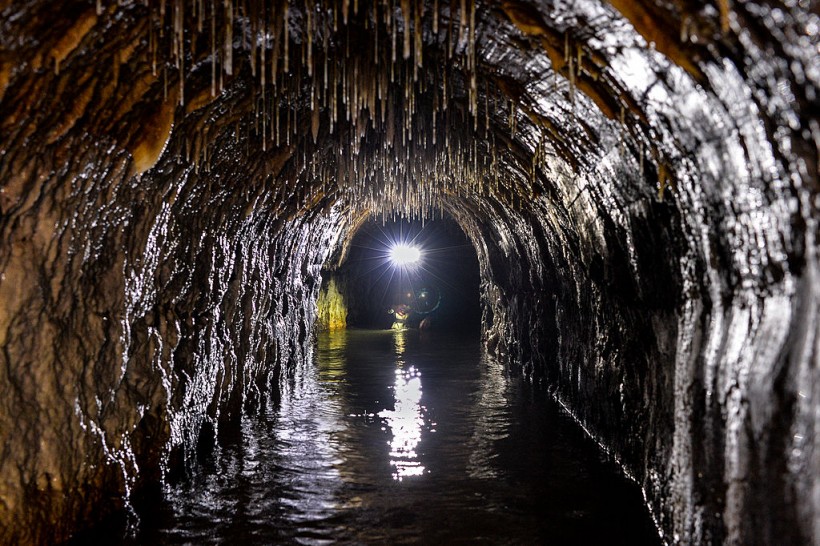About 40 years ago, children in Naples were happily playing in caves and tunnels beneath the hill of Posillipo in Italy without knowing that it was a vast subterranean Roman aqueduct.
But they recently revealed their recollections to archaeologists who started an investigation into one of the world's longest and most intriguing ancient water infrastructures in the Roman world.

A technician walks on October 25, 2013 in the Acqua Vergine aqueduct, one of the 11 roman aqueducts which supply almost all of the most imposing and magnificent fountains in the downtown area of Rome (Piazza Navona, Four Rivers, terrine, etc ...) and, above all, the Trevi Fountain.
What Are Roman Aqueducts?
According to National Geographic, the Roman aqueduct was a waterway that carried fresh water to densely inhabited areas. Aqueducts were incredible achievements of engineering given the historical period. Romans improved on the design of other civilizations and built a vast and complicated network across their empire.
Aqueducts needed extensive planning since they were built using a network of pipelines, tunnels, canals, and bridges. They make use of gravity and the natural slope of the terrain to transport water from a freshwater source, such as a lake or spring, to a city. Water was utilized for drinking, irrigation, and feeding hundreds of public fountains and baths as it poured into cities.
The bridges built with rounded stone arches may be the most distinctive characteristic of Roman aqueducts. Some of these can still be found traversing European valleys today.
However, these bridging constructions constituted just a minor percentage of the empire's hundreds of kilometers of aqueducts. Rome alone had 11 aqueduct systems bringing freshwater from sources as far distant as 92 kilometers away (57 miles). Despite their age, certain aqueducts continue to work and supply water to modern-day Rome.
READ ALSO: Ancient Rome Had Extremely Durable Concrete Structures Thanks to Their Materials and Techniques
Aqua Augusta: Least-Documented Roman Aqueduct
Rome's famous aqueducts served many purposes to the Romans, but this ancient architecture represents only a small fraction of the actual water system as most of them are hidden underground.
Subterranean aqueducts and their routes are significantly less well-known outside of Rome. This information gap includes the recently discovered Aqua Augusta, also known as the Serino aqueduct, which was built between 30 B.C. and 20 B.C. to link affluent homes and suburban outposts in the Bay of Naples.
According to Live Science, the Aqua Augusta is believed to have spanned at least 87 miles (140 kilometers) around Naples and ran down to the ancient holiday spot of Pompeii, to supply water to people all along the coast as well as inland.
However, the intricate Aqua Augusta has received little attention from academics, making it the least-documented aqueduct in the Roman world. The nonprofit organization Cocceius Association discovered this interesting aqueduct earlier this month. Locals who used to play there as a child also helped in the discovery of Aqua Augusta.
Graziano Ferrari, president of the Cocceius Association, told Live Science in an email that Aqua Augusta's interior air is good because it goes relatively close to the surface where wind frequently runs through the tunnels. But exploring the aqueduct would need extensive caving skills as it is challenging to traverse with all the thicket of thorns at one entrance.
Rabun Taylor, a University of Texas at Austin professor of classics who was not involved in the study, also emailed Live Science that the newly discovered aqueduct section is interesting because it is a byway that served elite Roman villas and not a city. That means it required careful maintenance and strict rationing due to multiple demands from its single water source.
As an expert on Roman aqueducts, Taylor said that the newly found Aqua Augustus could help scientists in learning more about the local climate over hundreds of years when water was still flowing.
RELATED ARTICLE: Explaining Ancient Roman Concrete: MIT Researchers Solve Durability Mysteries of Pantheon and Archaic Structures
Check out more news and information on Archaeology in Science Times.


![Earth's Quasi-Moon Kamo‘oalewa Could Originate From Lunar Surface Not Asteroid Belt [Study]](https://1721181113.rsc.cdn77.org/data/thumbs/full/53275/89/56/50/40/earths-quasi-moon-kamo-oalewa-could-originate-from-lunar-surface-not-asteroid-belt-study.png)











